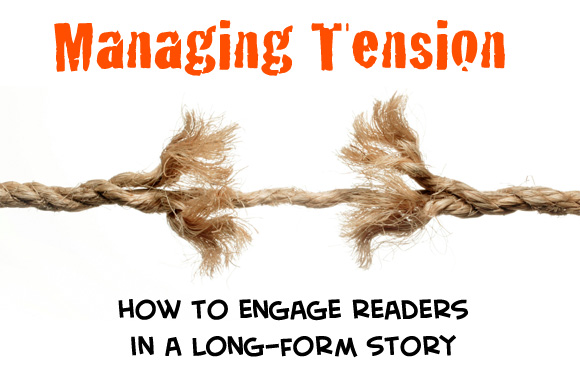Managing Tension
Posted by Robin Childs on December 23, 2013 News | Tags: advice, creating questions, how to, managing tension, writing | No comments
A humor strip has a well-established formula for getting readers hooked, and it can be as simple as a Set-Up and a Punchline. Quick, easy to digest, and entertaining. If a person finds it funny, they’ll be back again, and they might comb through the archives for more chuckles and laughs. Done! Reader Caught!
But what about the long-form comic, that often has no punch-line? How do we get people to come back for more with just that first impression?
There is no reason long-from comics can’t catch the reader at the very first page they see, regardless of where it is in the storyline, and keep them coming back for more. It just requires a different type of thinking than a gag comic strip.
The Rhythm of Writing
Every event or conversation has moments of tension and resolution. A good humor strip will tap into this flow for the best effect, setting up tension and then resolving it in an unexpected way. We laugh, because we had an expectation for how that tension would resolve, and when it doesn’t finish up the way we thought we find it funny. The joke always ends, even if the punchline is that it “doesn’t,” there is a form of resolution.

Long-form stories tap into the same rhythm, but at a completely different time. Long-form pages start with tension, typically residual from a previous page, resolve that tension in the body, and create a new state of tension afterward. Drama is driven by moments of macro- and micro-tension, or as I like to call them, cliff-hangers and mini-cliffs.

Macro- and Micro-tension
Macro-tension, commonly known as cliff-hangers, are pretty familiar and easy to do. In long-form comics these are typically the splash pages. They represent some grand event that could transform the lives of the characters in a potentially permanent fashion. This could be in the form of a literal transformation, such as a person gaining a special power, or from more mundane changes such as making a major decision or discovery, or experiencing a great loss.
However, a reader cannot be yanked from one splash page to the next for very long without jarring us out of the natural rhythm of tension/resolution, creating an overwhelming and numbing experience. So what about the parts in between each cliff-hanger? How can we hook people on a non-splash page? This is where the micro-tension mini-cliffs come in. Each person’s life is filled with many mini-cliffs each and every day. Small choices, questions, accidents, mistakes, and so on. Jokes and forms of levity can also find their way into a dramatic story as a way to resolve these mini-cliffs before diving into the next moment of micro tension. This can provide much-needed breaks to a dramatic story, particularly if it’s an unusually dark tale.
Let’s go back to our Dog and Chicken example. Instead of setting up the joke, we’re going to start in the middle, (assume the context was provided on the previous page). Since the joke is resolved, the next part of the flow is to set up micro-tension again.

Instantly, the reader’s mind fills with questions. Who is calling? Are they angry? If so, why is the dog not more concerned? Is the person/thing calling happy? If so, why does the chicken seem concerned? Why is the dog named DOG? Couldn’t the author be more original??
(The answer to that last one is “no” by the way.)
The reader instinctively knows that the next page will give them new information about the characters we’ve already met, and perhaps introduce us to other members of the cast or expand the world. People crave resolution and like learning new things. By creating micro-tension, we implant the need to either return for the answers, or see if they can solve the mystery intuitively using previous material in the archive. It is likely that none of the information in the next page will earth-shattering, but the questions get the reader engaged on some level.
Micro-tension can also be transformed in the next page into Macro-tension, using the reader’s expectation of a small resolution to surprise them with a different result. For example, the next page of Dog and Chicken (the most amazingly named webcomic EVER) we could be introduced to Lizzy, the hyper-active toddler, or SOULMASHER THE TERRIBLE, A HIDEOUS BEAST THAT SHALL MAKE YOU WEEP TEARS OF BLOOD TO GAZE UPON ITS HIDEOUS VISAGE!
Or, you know, ChronoGato the time-traveling cat. There are options.
Tension engages better than information
People don’t need to know what’s going on to be caught by the tension in a page. Long-form readers are by necessity interested in story and setting, otherwise they wouldn’t be bothering with a graphic novel! Chances are, they will seek out more information if it is of interest to them, so while I make such material available, my focus is to make each an every page engaging enough to get a visitor wanting more, whether they just found my site or have been reading from the very first page!
Naturally, there is a lot more to KEEPING a reader than just managing tension, but tension management is a crucial part to get people engaged and entertained by a storyline from the very first impression.
